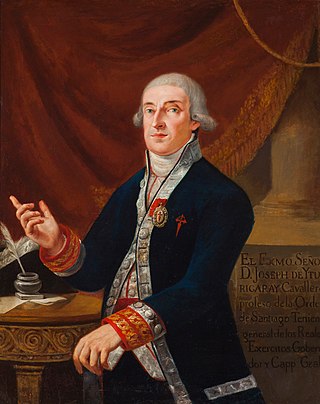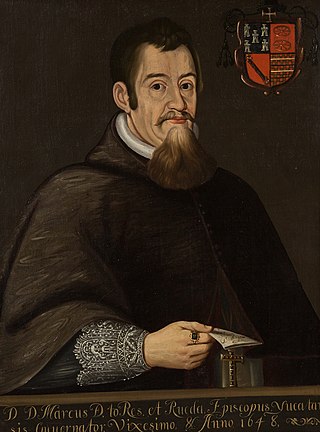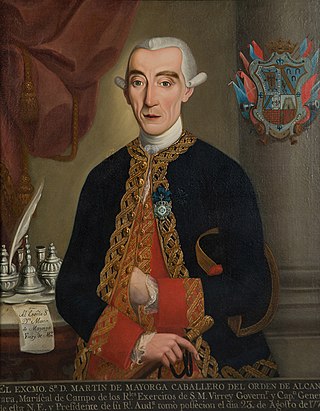Biography
Dr. Malo de Villavicencio was a native of Seville, Spain. He arrived in New Spain in 1709. As prosecutor in the Audiencia, he made a comprehensive report to the viceroy on the infestation of brigands on the highway between Puebla de los Angeles and Mexico City. For this and other valuable work, the military auditor rewarded him with the rank of colonel of infantry. The auditor did this by completing one of the blank letters patent the king had supplied him to reward such services.
He was president of the Audiencia when Viceroy Pedro de Castro y Figueroa died, on August 22, 1741. In this capacity, he served as interim viceroy until April 30, 1742, when the new viceroy, Pedro Cebrián, 5th Count of Fuenclara, arrived to fill the vacancy.

José Joaquín Vicente de Iturrigaray y Aróstegui, KOS was a Spanish military officer and viceroy of New Spain, from 4 January 1803 to 16 September 1808, during Napoleon's invasion of Spain and the establishment of a Bonapartist regime in Spain. His plans to form a provisional autonomous government led to his arrest and deposition.

Álvaro Manrique de Zúñiga, 1st Marquess of Villamanrique, Spanish nobleman and the seventh viceroy of New Spain. He governed from October 17, 1585, to January 26, 1590.

Marcos de Torres y Rueda was bishop of Yucatan (1646–1649), interim viceroy of New Spain, and president of the Audiencia of New Spain. He served in office from May 13, 1648, to April 22, 1649. His name is sometimes given as Marcos Torres y Rueda.

Pedro de Castro y Figueroa y Salazar, 1st Duke of la Conquista, 1st Marquess of Gracia Real, KOS, OSJ was a Spanish military officer and viceroy of New Spain.

Pedro Cebrián y Agustín, 5th Count of Fuenclara, Grandee of Spain, was a Spanish diplomat and viceroy of New Spain, from November 3, 1742 to July 8, 1746.

Matías de Gálvez y Gallardo, KOS was a Spanish general, the Captain General of Guatemala from April 1779 to 3 April 1783, and Viceroy of New Spain from 29 April 1783 to 3 November 1784.

Antonio María de Bucareli y Ursúa was a Spanish military officer, governor of Cuba, and Viceroy of New Spain from 1771 until his death in 1779. His military service included campaigns in Italy and Portugal. He rose to the rank of lieutenant general while serving as inspector of coastal fortifications in Granada. In 1766, Bucareli entered the Spanish colonial administration as governor and captain general of Cuba. His record there earned him appointment as viceroy of New Spain in 1771.

Martín de Mayorga Ferrer was a Spanish military officer, governor of the Captaincy General of Guatemala, and interim viceroy of New Spain.

Pedro de Garibay was a Spanish military officer and, from September 16, 1808 to July 19, 1809, viceroy of New Spain.

Francisco Javier de Lizana y Beaumont was bishop of Mexico and, from 19 July 1809 to 8 May 1810, viceroy of New Spain.
Francisco Ceinos was one of five oidores (judges) of the second Real Audiencia of Mexico. This group governed the colonies of New Spain from January 10, 1515 to April 16, 1535. Ceinos was also president of the audiencias that served as interim governments of New Spain from 1564 to 1566 and from approximately July 1568 to November of that year.
Alonso Muñoz was a high-ranking administrator in Spain and, from November 1567 to about July 1568, royal commissioner with Luis Carrillo for the inspection of the government of New Spain for King Philip II.
Luis Carrillo was, from November 1567 to about July 1568, royal commissioner with Alonso Muñoz for the inspection of the viceregal government of New Spain for King Philip II.
Francisco Antonio de Echávarri was a Spanish colonial official in New Spain. He was president of the Audiencia of Mexico City in 1760 when Viceroy Agustín de Ahumada died in office. In that capacity, Echávarri served as acting viceroy until the arrival of Francisco Cajigal de la Vega, Ahumada's successor. He served from February 5, 1760 to April 28, 1760.
Francisco Romá y Rosell was a Spanish royal official in Valladolid and New Spain. He was the first regent of the Real Audiencia of Mexico. In this capacity, after the death of Viceroy Antonio María de Bucareli y Ursúa and before the arrival of his successor, Martín de Mayorga, Romá served as interim governor of the colony from April 9, 1779 to August 23, 1779.
Doctor Luis de Villanueva y Zapata was a Spanish colonial administrator in New Spain.

Antonio José Amar y Borbón Arguedas was a Spanish military officer and colonial official. From September 16, 1803 to July 20, 1810 he was viceroy of Viceroyalty of New Granada. During his mandate he faced the beginning of the independence movement. He is also remembered for introducing costumes and masked balls in the society of Bogotá.

Antonio Villavicencio y Verástegui was a statesman and soldier of New Granada, born in Quito, and educated in Spain. He served in the Battle of Trafalgar as an officer in the Spanish Navy with the rank of Second Lieutenant. He was sent as a representative of the Spanish Crown to New Granada, where his arrival was used as an excuse in Santafé de Bogotá to start a revolt; this was known as the Florero de Llorente, which culminated in the proclamation of independence from Spain. After this incident he resigned his office and joined the cause of independence. He was later captured and became the first martyr executed during the reign of terror of Pablo Morillo.
The Real Audiencia of Mexico or Royal Audiencia of Mexico was the highest tribunal of the Spanish crown in the Kingdom of New Spain. The Audiencia was created by royal decree on December 13, 1527, and was seated in the viceregal capital of Mexico City. The First Audiencia was dissolved by the crown for its bungling and corruption and the crown established the Second Audiencia in 1530. This was supplanted by the Viceroyalty of New Spain in 1535. A new Audiencia was created in Guadalajara in western Mexico in 1548.
The Royal Audience and Chancery of Panama in Tierra Firme was a governing body and superior court in the New World empire of Spain. The Audiencia of Panama was the third American audiencia after the ones of Santo Domingo and Mexico. It existed three times under various guises since it first creation in 1538 until its ultimate abolition in 1751.












